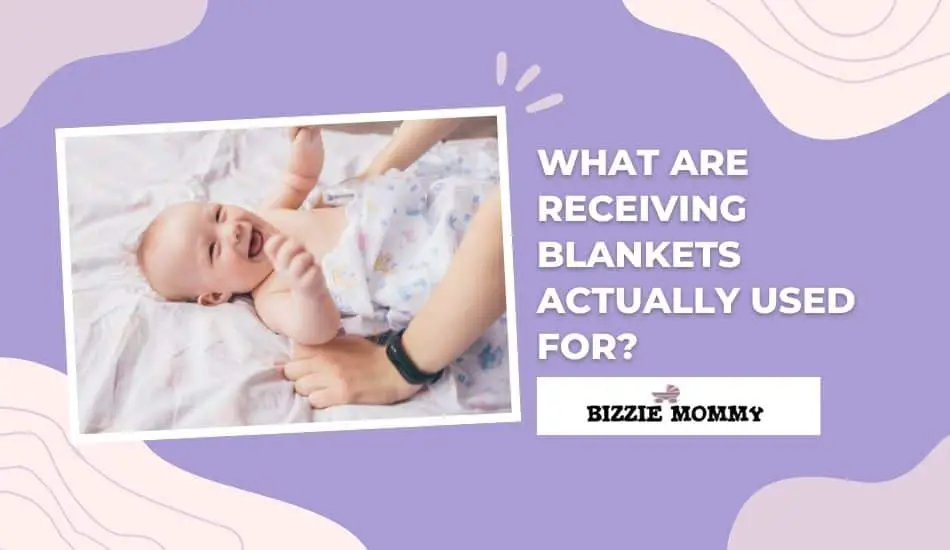As a new parent, you must be feeling quite stunned by the number of baby “essentials” that exist today. Thanks to the thriving baby market, there are tons of products that are categorized as baby essentials these days, and blankets are one of them! However, there is an insane variety of baby blankets.
Newborn babies need swaddling to keep them calm and to put them to sleep. Fortunately, you can swaddle babies and make them sleep for hours using a swaddling blanket. The low price of swaddling blankets, which start at around $20, makes them affordable enough to own several sizes.
A receiving blanket fully covers a baby’s tiny body and keeps your baby warm. Due to its silky fleece texture, it surrounds the baby in comfort. They are the perfect size at thirty to forty inches and light enough for you to carry around.
But are receiving blankets multi-functional? Are they safe to use? Let’s find out!
What is the Use of a Receiving Blanket?
A receiving blanket is one of the handiest baby blankets. Because of its longer length, it can be utilized for various purposes when a smaller blanket just won’t do.
If you have an excess of newborn receiving blankets, you can put them to good use. How? Keep reading!
Play mat
A baby needs his or her own play area, as recommended by doctors, for proper cognitive growth and developing motor skills. If you do not have a specific play space for your baby, a receiving blanket can be used as a play mat.
Newborn babies do not require a lot of space and can easily play on top of the blanket. These blankets are typically large enough to let your child move, play, cuddle, and even fall asleep on.
Mom’s womb alternative
If you swaddle your baby in a receiving blanket, it will give the same feel as a mom‘s womb. This is because it is designed for that purpose. It is a wonderful first blanket option for your baby.
You may wrap your infant with a regular receiving blanket, folded in half with winged sides. It will keep him or her warm and cozy and increase sleeping hours.
For Breastfeeding
New parents do not always have a say in when or where they must stop to feed their babies. It doesn’t matter to babies whether you are at a party, on public transport, or at work. Understandably, it can be incredibly uncomfortable for mothers to breastfeed their infants in public spaces.
A simple solution is to keep a comfortable baby blanket for yourself and your infant. If you have this blanket available, you can put it over your baby for a feeding session. This will definitely give you a sense of privacy by acting as a nursing cover.
Changing station
As a new parent, you may find that public spaces don’t always provide adequate changing stations. You might end up outdoors, at a restaurant, or even in a public restroom that does not have a changing table. You’ll want to protect your baby from germs that can make him or her sick. A receiving blanket can be used as a changing station.
If you have an extra blanket for changing your baby’s diaper under these circumstances, it will keep him or her safe. You can easily carry it around in your diaper bag. It is not an ideal situation, but it will work to keep your baby safe.
Stroller cover
A receiving blanket can be used as a stroller cover when you take your baby for a stroll in the park. It is a good idea to use your baby’s blanket as a stroller shade to keep him or her safe from harsh sun rays and strong winds. All you need to do is keep the receiving blanket with you when taking walks.
Burp cloths
A newborn baby may spit up its food if not adequately burped. This may happen several times a day. For this purpose, you can use receiving blankets as burp cloths, which are typically smaller in size because they are meant to go over a parent’s shoulder.
Receiving blankets provide more protection than an undersized burp cloth. They don’t have to be positioned just right since they already cover a larger space. Even if you already have burping cloths, receiving blankets can be used for those times you forget them or just don’t have one close by.
Plaything
Receiving blankets can be used for playing with your baby. Games keep your baby engaged and may stop them from crying excessively.
Try playing the traditional peekaboo baby game. It is one of the most common ways to make your baby laugh. Because the receiving blanket is not extremely large or weighty, your baby may comfortably handle it while playing without being afraid.
Baby Bib
A receiving blanket can be used as a baby bib. Babies are messy eaters, and no matter how hard you try to teach them to eat correctly, their self-feeding tendencies will win! This is where the large receiving blanket-bib comes in handy.
It’s a great idea to try to keep your baby’s clothes from becoming filthy by wrapping the receiving blanket around his or her neck and letting it drape over his or her chest.
Apron
A receiving blanket can be used as an apron. Babies enjoy colorful paints, and playing with crayons helps them develop their motor skills. You may use a receiving blanket as an apron to keep your baby’s clothes clean while he or she enjoys a crafty evening with paint.
This will save you the hassle of washing clothes every time your baby has tummy time or playtime with messy art supplies.
Reusing Old Blankets
Once your infant grows up and no longer needs a receiving blanket, you may find yourself with a pile of old, leftover blankets from his or her baby days.
You can use these old receiving blankets for many other purposes. You can use one as your pet’s blanket or for another household purpose. You could also give it to someone else who needs it.
What is the Purpose of Swaddle Blankets?
Swaddle blankets are identical to smaller receiving blankets, but they’re designed specifically for swaddling. The shape of the blanket and the material are what make these blankets ideal for swaddling.
Fabrics that stretch, like muslin or jersey, are used to make swaddle blankets. The elastic material allows you to wrap the fabric around your infant more firmly, making them feel protected and secure. They may also have flaps that help to achieve a swaddle or even Velcro to help new parents with the swaddling procedure.
Swaddling may, at first, appear to be a type of simple folding, but there is a little bit of a learning curve for this. However, it is not entirely impossible and you can easily master the art of swaddling to provide your baby with the additional parental warmth that they need excessively during their initial years.
So, how do you swaddle your baby?
Make a triangle by folding the upper corner of the blanket down to meet the bottom corner. Place your baby on top. One by one, wrap both left and right corners. Cover your baby like a burrito roll. And that’s it! Just make sure it is not too tight for your baby’s body.
Advantages of Swaddling Blankets
Swaddling provides several advantages for new babies, such as:
- Providing a baby with a cozy, snug environment, like a mother’s womb.
- Keeping your baby from being surprised or scared when he wakes up.
- Swaddling a restless or fussy infant helps them relax.
- Swaddling can help your baby sleep better and for a longer period of time.
- Aiding in the development of safe sleeping habits by keeping loose or thick blankets out of the cradle or cot.
What is the Difference Between Swaddle Blankets and Receiving Blankets?

Are receiving blankets really swaddle blankets? They share similar features, such as breathable material, soft cotton composition, purpose as a baby wrap, and essentially being a baby product.
A swaddle is a blanket cover used to cocoon a baby, while a receiving blanket is a small baby blanket that may be used to cover a baby. Swaddle blankets and receiving blankets are considered synonymous.
In comparing receiving blankets and swaddle blankets, the major difference exists in terms of size. Swaddle blankets are larger than receiving blankets.
Moreover, swaddle blankets are composed of thin materials, such as muslin, while receiving blankets are made of soft cotton fabric. This makes receiving blankets thicker.
Other than that, they can be used interchangeably.
What is a Receiving Blanket for a Hospital?
Your due date is just around the corner, which implies your baby might come at any time! You’re probably both excited and apprehensive about giving birth. Plan early and have your baby products organized at least three weeks before your due date in order to prevent stress.
There are many things that a mom-to-be should take to the hospital. Baby blankets (receiving blankets, in particular) are one of the items that you must add to your list without second thoughts.
You may need more than one blanket for your time in the hospital. This is because a child is covered in fluids and medication. You may want to change the blankets after every few hours.
The number of blankets that you will pack also depends upon your stay in the hospital. If you are having a c-section, your stay will be long, which means you will need a plethora of receiving blankets. If you are having a normal delivery, two to three blankets are more than enough.
Choosing a Receiving Blanket for Hospital
For a mom-to-be, choosing a good receiving blanket will be a good starting point for the preparation of receiving the baby. Personal preference and the climate in which you reside will determine the material you will choose for your baby’s receiving blanket.
Usually, a newborn needs lots of warmth, as it is new to the outside environment. For that, thick blankets are perfect. You can consider the average temperatures in your area. If it is too hot, you might consider buying lighter blankets.
For warmer climates, lighter textiles like cotton and linen are appropriate. For chilly weather, a heavier fabric, such as flannel, is ideal. Assess how many you’ll use in the summer versus winter, depending on where you reside.
Receiving blankets are available in different shapes and prints. You can choose and select according to the gender of your baby.
How Many Receiving Blankets Does a Newborn Need?
You should have at least seven receiving blankets and four swaddling blankets at hand when your baby comes into this world. After spending some quality time with your infant, you’ll be able to tell if you prefer one blanket over the other.
It is also quite possible that you end up using all eleven of these blankets and assign a different purpose for each. For obvious reasons, every baby and mother has different needs and preferences and you have the right to design a unique routine and habit schedule for yourself and your baby.
It’s crucial to keep in mind that babies are uncontrollably untidy. You’ll end up changing your baby blanket multiple times a day due to spit-up and the baby’s diaper overflowing. If this happens more frequently with your child, consider keeping extra blankets with you at all times.
Summary and Final Verdict
Now that we know what the swaddle blankets are meant for, you can enjoy an amazing parenting experience with your newborn baby.
Newborn baby receiving blankets may be used to cleanse, warm, wrap, and even prevent overheating in infants. You can even create a comfortable and safe environment for an infant with thin blankets. However, it is important that you select a couple of different types and keep a variety of colors just to keep things interesting and cute!

